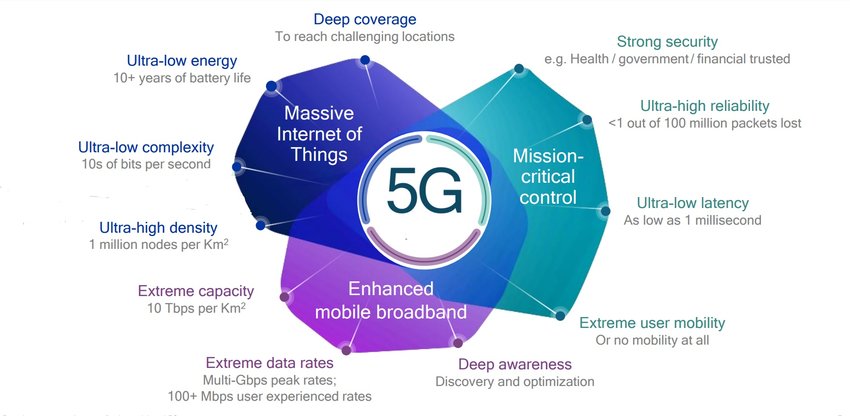Facing Today's 5G Issues and Challenges

In recent years, 5G adoption has been viewed as a race, with the earliest adopters seen as the "winners" — of the biggest business opportunities and the first chances to sell the new technology to customers. But an array of 5G issues and challenges have caused deployment to play out a bit differently than anticipated.
Rather than a marathon progressing deterministically toward a finish line, it's been more like a puzzle to be put together piece by piece. Even though the puzzle isn't yet complete, you can begin to imagine what the final 5G picture will look like as the pieces come together.
5G technology has no doubt matured in the past two years. Cellular service providers began releasing the first 5G-enabled smartphones in mid-2020, with more on the way. Good progress has been made to develop and deploy wireless infrastructure technologies like massive multiple input-multiple output (mMIMO) and millimeter wave (mmWave), both of which contribute to 5G's improved speeds. Innovative hyperscalers, like Google and Amazon Web Services, have even started hosting their own 5G virtual network capabilities.
In addition to technological progress, the business and commercial landscape has expanded. New entrants are emerging. Existing players — from cellular service providers (CSPs), cloud network developers and infrastructure vendors to manufacturers of antennas, chipsets and modules — are all interacting in new and interesting ways. The relationships between customer, supplier and collaborator are ever evolving.
The promise of 5G is still there: higher data rates, mission critical connectivity and support for Massive Internet of Things (IoT). Businesses are thinking about the value proposition of 5G — the role it plays in Industry 4.0 and the benefits of connected devices, data, automation and artificial intelligence.
However, actual adoption is still in the early stages. While deployments are well underway globally, 5G has not yet made the impact on our daily lives that 4G made. In a survey of 193 telecommunications stakeholders fielded by Jabil and SIS International Research in the fall of 2021 about the challenges and opportunities associated with 5G deployment, only 14% of respondents said they believe 5G usage is already mainstream. Nearly two-thirds, 64%, believe it will take another one to three years, while 19% believe it will be three to five years before 5G is widely adopted.
There's been plenty of investment in 5G technology development, in spectrum to deploy 5G and in networks to support 5G. Nevertheless, we have not yet seen the enthusiasm and economic boom that accompanied 4G. Why is that?
Let's explore how the technology and the ecosystem have evolved over the past several years and how we can overcome the new challenges we face in building the age of 5G.
Download the full 5G Technology Trends Survey Report.
The 5G "Triangle" Has Grown in Diversity & Complexity
As the technology underpinning 5G has become more developed, a realization of the complexity of 5G has come along with it. Early capability charts showed the famous triangle that highlighted 5G's three main benefits — faster speeds, lower latency and the ability to host many more IoT connections at once.
As the 5G standards have evolved, more features have been defined and added, to the point where an 11-axis spider diagram is now required to summarize the capabilities visually. The areas where 5G provides substantial improvements over 4G are:
- Enhanced mobile broadband
- Extreme data rates (multi-Gbps peak rates; 100+ Mbps user-experienced rates)
- Extreme capacity (10 Tbps per km2) to handle more devices in a small area
- Deep awareness (discovery and optimization for machine learning)
- Mission-critical control
- Ultra-low latency (as low as 1 millisecond of lag time)
- Ultra-high reliability (10-5 per 1 millisecond)
- Strong security (especially important for healthcare, government and financial institutions)
- Extreme user mobility (connection is maintained for devices/vehicles moving up to 500 km/h or 310 mph)
- Massive Internet of Things
- Ultra-low energy connections that help give IoT devices 10+ years of battery life
- Ultra-high density (1 million nodes per km2) so more devices can be connected simultaneously
- Ultra-low complexity (10s of bits per second)
- Deep coverage
Clearly the 5G specifications have grown in richness and capabilities. Having such a diverse "toolbox" of capabilities is a great benefit to service providers; it enables them to customize and optimize their networks tailored to customers' needs and to add new and innovative services.
However, this richness of capabilities could also present some difficulties. The companies developing 5G products and services now have a much broader spectrum of features they need to develop. This will require a significantly larger investment than in prior generations. Also, these companies are typically resource-constrained, so they will need to prioritize which feature sets they develop and decide which features they will defer.
Challenges do not exist only on the supply side. The customers for these products and features, the service providers, generally have different strategies on how to deploy 5G. As such, they would tend to focus on a subset of 5G features that they would purchase. Since not all service providers are interested in all features, there will likely be an overall dilution in the willingness to pay across the broad 5G feature set.
The breadth of features and the investment required could lead to a slower rollout of 5G features. Dilution on the demand side could present challenges to the overall economics of 5G. Almost a third of respondents in Jabil's 5G survey (31%) indicated that these business model challenges were the most difficult category of 5G issues for their organization to solve, compared with 19% who were most challenged by operational hurdles, 18% technology challenges and 16% by supply chain or customer issues. It seems that telecommunications companies have yet to determine how to best package 5G, as creating subscription models was the biggest business challenge faced by survey respondents (31%). It will be interesting to observe the balance between these challenges and the substantial benefits of the broad capabilities in the 5G "toolbox."
5G Spectrum Allocation, Investment and Deployment Are Happening — But Slowly
As noted previously, there has been lots of progress in technology rollout and investment in product development for 5G. So why don't we see ubiquitous high-speed 5G service affecting our daily lives?
To provide that pervasive high-speed coverage over a broad geographic area requires the wireless equivalent of real estate — namely spectrum. This spectrum needs to be allocated, typically by national regulatory bodies, and then equipment needs to be deployed to utilize the spectrum. This takes time.
It is quite well known that there has been substantial activity in allocating spectrum on a global basis. There has also been a high degree of enthusiasm to invest in this spectrum, as evidenced by the recent $81 billion auction of mid-band spectrum in the U.S.
The question of how much time is required to deploy it depends on which area of the 5G spectrum we're talking about. There are a variety of speeds and services available within the 5G spectrum bands.
For mid-band 5G spectrum (in the range from around 1 GHz to 6 GHz) the time factor is driven by the fact that the spectrum is not immediately available for use. After an auction happens, it can take many months to clear the spectrum and deploy the equipment that will eventually operate in that band. For example, the spectrum awarded in the United States' February 2021 auction is expected to be available in December 2021 for service providers to begin testing. At that point, the challenge shifts from a spectrum availability problem to an equipment investment and deployment problem.
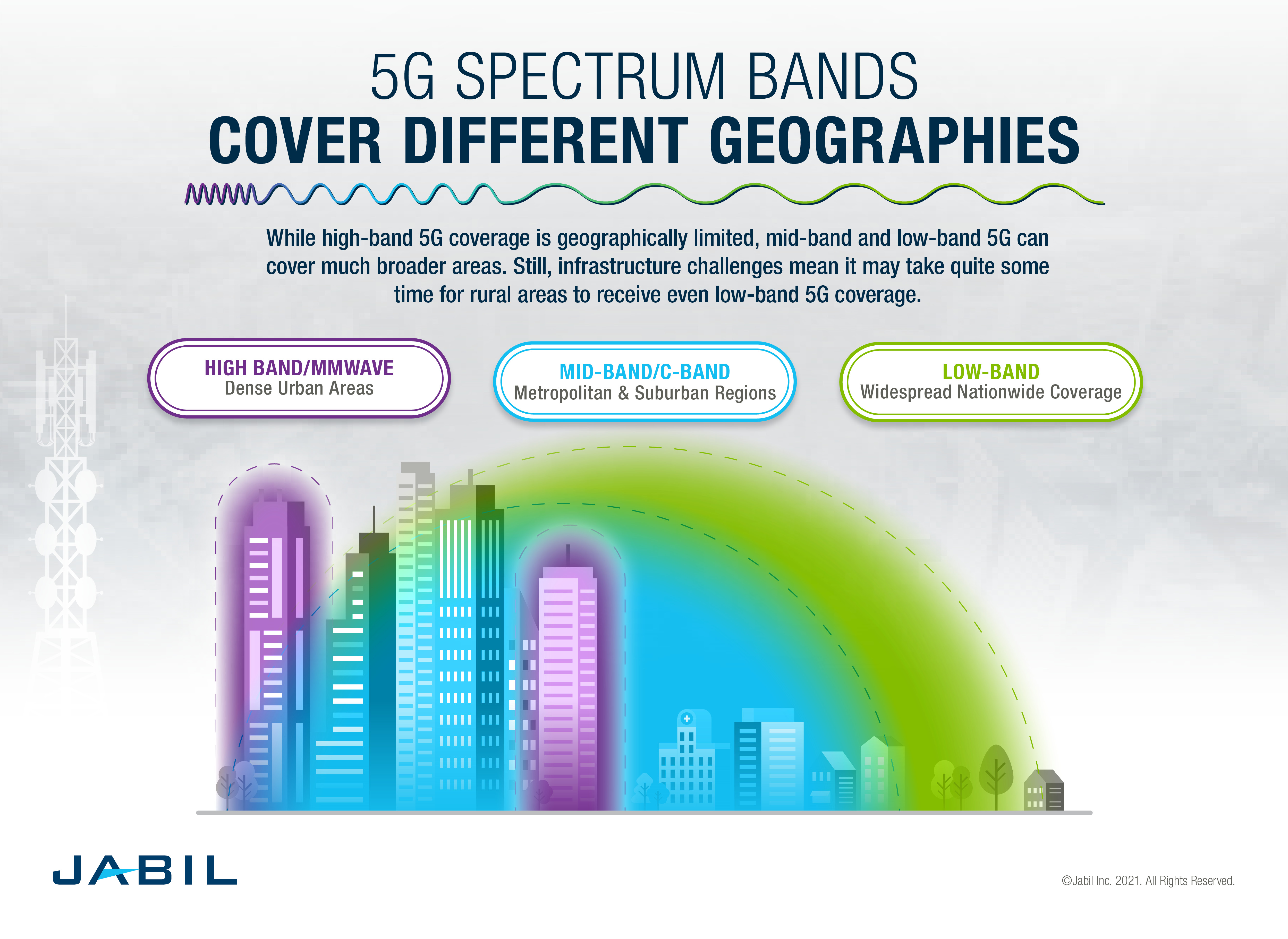
5G spectrum bands cover different geographies
The dynamic for high-band spectrum (from 24 GHz to 40 GHz) is different. In this case, the spectrum is generally clear, and there's plenty of "real estate." However, to get good high-band coverage, many millimeter-wave base stations must be deployed. This is due to the fact wireless signals do not propagate, or travel, very far distances in this band. Typical coverage for a base station in this band is several hundred meters, requiring many base stations to provide service across a broad geographical area.
Similar to traditional small-cell deployments, it can take substantial time to obtain leases, site approvals, power and connectivity for the site. Compounding this across the many sites required presents a difficult and time-consuming logistical process; nearly one-third of Jabil's 5G survey respondents (32%) said identifying the physical locations to install 5G equipment was a hurdle to their organization's 5G deployment, the most common challenge amongst respondents.
In either case, the combination of spectrum licensing costs and equipment deployment will add up to a substantial investment for network operators and service providers. The critical question then becomes, "What will generate the revenue to offset that investment?"
The answer could lie in the elusive killer app.
Where Is the Killer App?
At this point in time, the question "What is 5G?" is generally answered in terms of capabilities: extreme capacity, ultra-low latency and ultra-high reliability. None of these describe the actual user experience with 5G, and indeed, some of these capabilities are so esoteric that typical users may not be able to relate to them.
When the user experience is considered, you might respond with answers such as, "It's faster, security is stronger and reliability is better." These are attributes that users can relate to somewhat better. However, these are adjectives that describe an incremental experience.
As discussed earlier, the investments in technology development and spectrum are by no means incremental. They lean more toward astronomical. In order to balance these investments, the user experience in 5G cannot be incremental. It needs to be disruptive.
There is always talk of the "killer app," almost to the point that the term has become glib. However, in the case of 5G, the notion of a killer app that delivers a disruptive experience is essential. This is because, while there's certainly a lot of buzz around 5G, many consumers aren't sure what it's all about or whether they should invest in it when the time comes.
A recent study by Ericsson found mobile device consumers are willing to pay 20% to 30% more for 5G plans bundled with new apps and services. But that finding came with a big caveat. About 70% of current 5G users are dissatisfied with the lack of new and innovative apps. In other words, they want the killer app.
Admittedly, the question of the killer app is an easy one to ask but a difficult one to answer. Indeed, if I knew the answer, I might be in another line of business. However, we will soon look at some potential areas where the elusive killer app might emerge.
Solutions to the Biggest 5G Challenges
The complexity and diversity of the 5G specifications, the challenges of spectrum clearance and deployment, and the absence of a killer app are all headwinds facing 5G rollout. However, these are by no means intractable problems. The question is, what can be done about them?
A number of the current challenges — like spectrum clearing and auctioning, along with equipment deployment — will just take time and traditional effort to overcome. Cellular service providers in the U.S. have said they expect consumers to begin accessing the C-band awarded in spring 2021 by the same time next year. Extrapolate that out, and the C-band spectrum auctioned off in the fall of 2021 could be rolled out by the end of 2022. Considering only 12% of U.S. smartphone users have a 5G-enabled phone, this also gives consumers time to plan and make their device upgrades.
This also gives providers, operators and other players within the diversifying 5G ecosystem the opportunity to dig deeper into possible solutions for the hurdles the industry still faces — while also exploring new opportunities the technology presents.
Leveraging the Evolving 5G Ecosystem
While 5G has primarily depended on new, innovative technology for its solutions, in one case, new research is finding that existing, commercially available technology might be the best way to bring down the cost of in-demand millimeter wave coverage. Mobile Experts determined that operators could save up to 52% of the cost to deploy mmWave base stations by using a mix of wired and solar-powered smart repeaters to spread coverage between base stations — reducing the number of base stations needed in a given area.
The issue of 5G's complexity and diversity, and the solution to driving faster development of 5G's comprehensive feature set, will likely require a deeper engagement of the broader ecosystem. To that end, more companies outside of the traditional telecommunications industry and equipment providers are developing network and user equipment — like handsets, radios, small cells and customer premise equipment (a "5G box" you can put right in your home or building). Such efforts can address the broader needs caused by 5G's complexity. There is so much demand for 5G technology and equipment that the opportunity is ripe for disruptive companies, startups and new entrants.
Open Radio Access Network, or Open RAN, is a great example of this. Open RAN has three key elements: cloudification of the RAN applications, intelligence and automation, and open internal RAN interfaces. With an open network, a set of standard specifications across the industry would allow cellular service providers to deploy components from various OEMs for their 5G technologies — radios, digital units, and so on — to get highly competitive pricing and potentially more features. Additionally, a majority of Jabil's 5G survey respondents believe Open RAN adoption will help reduce their overall costs; 81% said it would help an organization cut their capital expenditures, while 85% believe it will help bring down their operational expenditures.
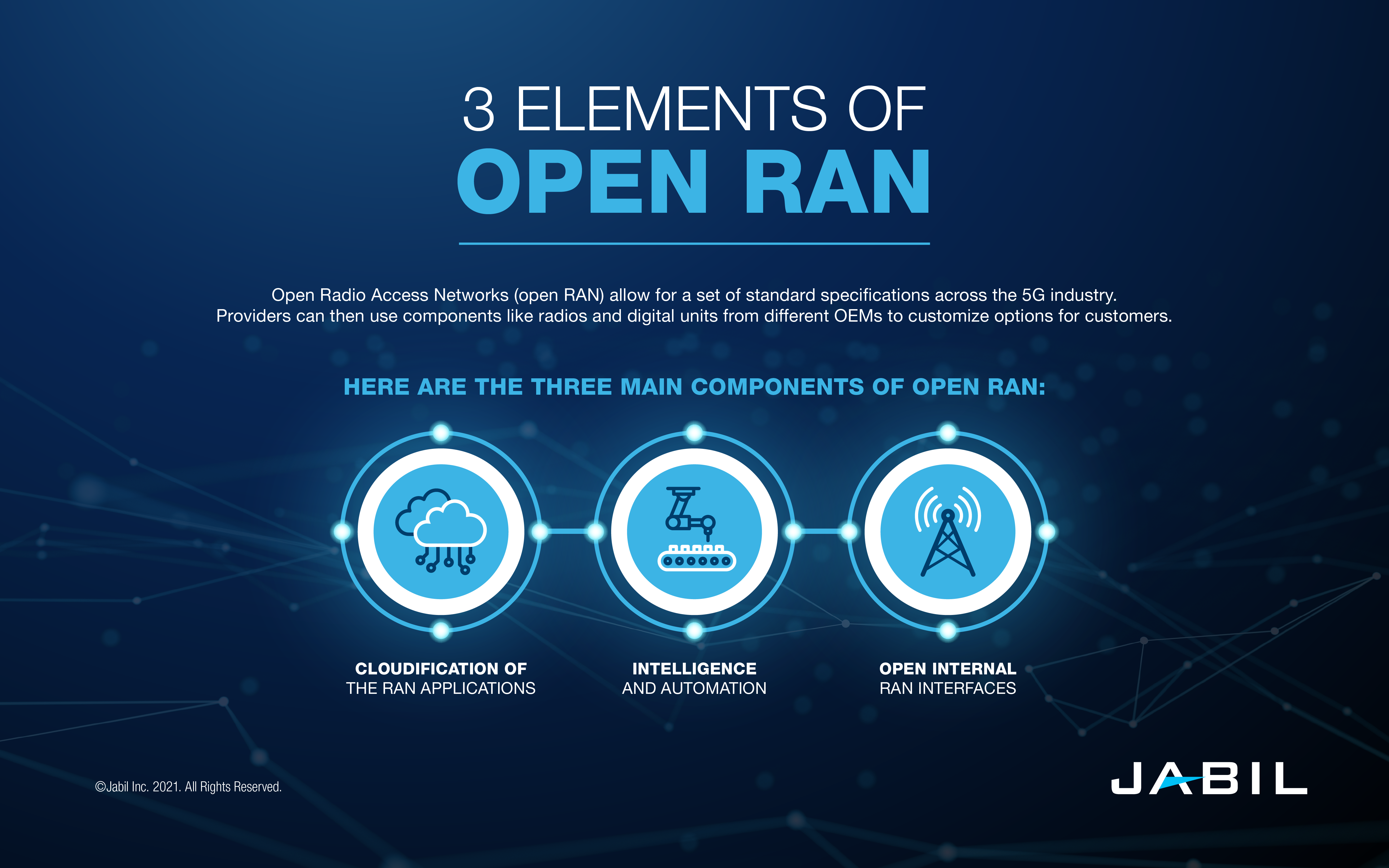
Three elements of Open RAN
Open RAN enables a broader and diversified supply of radio equipment from even non-traditional players to help meet the demands of all of 5G's many capabilities. With more equipment options, CSPs can customize their offerings and give customers an optimized 5G experience.
5G is creating an ecosystem that is welcoming smaller companies, startups and other businesses outside of the typical equipment manufacturers and cellular service providers. Hyperscalers and other non-traditional tier 2 companies are using Open RAN to host their own wireless network functions and develop the associated software, pushing the boundaries of what 5G can do and who can use it. However, some telecommunications stakeholders are still unsure how hyperscalers will fit into the 5G picture. More than half of Jabil's survey respondents (56%) said hyperscalers like Amazon, Microsoft and Google don't fit into their organization's Open RAN strategy.
Who Will Develop the Killer App?
Discussions about potential applications of 5G often include ideas such as private networks, fixed wireless internet and healthcare. Our survey respondents suggested financial services (22%), transportation (17%) and healthcare (16%) could be the industries that are most impacted by 5G. While these may seem incremental in comparison to 4G capabilities, let's examine two areas that may unleash unprecedented opportunities. The single most important element to fuel investment in the 5G ecosystem will be the emergence of applications that provide enough differentiation in capabilities to entice a power user or a family to pull an additional $10 or $20 per month out of their pocket. For a true killer app, we need to look deeper.
The 5G ecosystem is creating an environment for non-traditional technology companies to explore out-of-the-box connectivity or technology options. I would expect to see one of these disruptive players, companies similar to Facebook and Uber that came before them, hit on the killer app that truly ushers in the age of 5G. Overwhelmingly, survey respondents indicated they believe the killer app will benefit the business world most (58%), rather than personal (20%), enterprise (18%) or healthcare use cases (4%). Still, there are a few different areas we should keep an eye on for this eventual game-changer.
It is important to consider users who are on-the-go most often, generally in a business capacity. In previous generations, we may have called them "road warriors." Today, we might call them "digital nomads," or individuals who aren't tied to one location for work. Whenever the world opens up post-pandemic, what will these frequent fliers, long-distance drivers and serious streamers need to keep their GPS running and their video calls crystal-clear, wherever they are in the world? The key is understanding how to leverage key capabilities of 5G, which can power their lifestyle and make them more effective in ways that mark a drastic improvement over 4G.
A fundamental benefit 5G provides is the ability to securely provide reliable high-speed data in a mobile environment. Think about taking cutting-edge connectivity applications outdoors and on the road, which Wi-Fi cannot support effectively. There has been intriguing speculation on the future of AR/VR-enabled games and apps, exciting for a closet gamer like me. Further, imagine bringing true AR/VR experience and the "metaverse" (such as Facebook's Horizon Workrooms virtual office) to any environment. Ubiquitous human connectivity is a capability for which people have been paying a premium since the introduction of long-distance telephone service. Apps that provide a new level of connectivity, ones that consumers are willing to pay extra for, are exactly the driver that can fuel the economic engine of 5G.
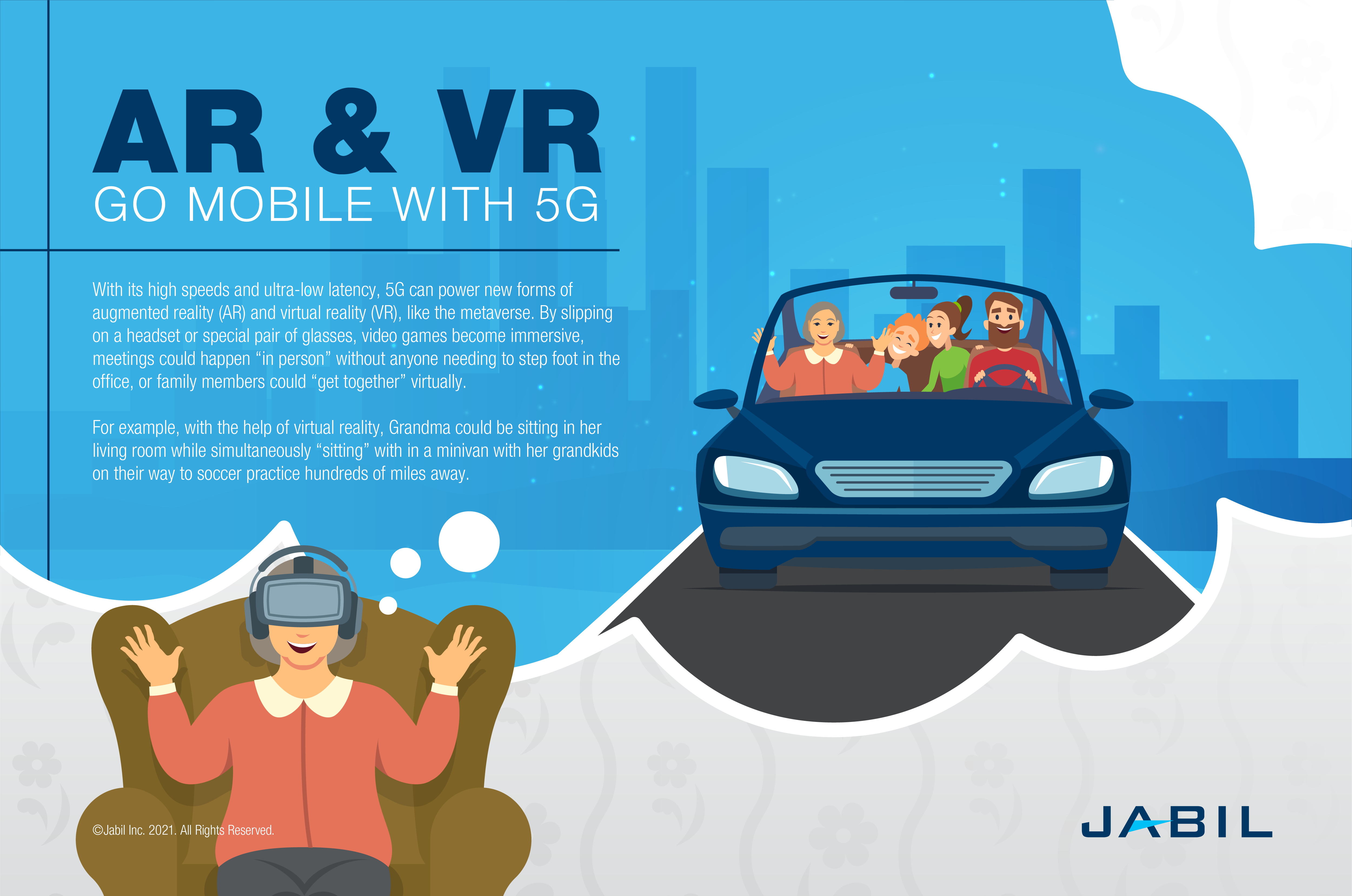
Augmented and virtual reality go mobile with 5G
There is hardly a technology article written these days that does not reference artificial intelligence or machine learning (this one included). Slowly but surely these technologies are making their way into our everyday lives, from smart home voice assistants to their use in fields like healthcare (to discover new drugs) or renewable energy, optimizing systems based on sensors and weather data. The algorithms and techniques have progressed greatly in the past decade. The enormous amounts of data required to fuel the algorithms have been collected, are available and are growing.
However, imagine challenges for AI in a mobile environment; having enough processing power in the hands of the mobile user and having immediate access to vast amounts of data are the biggest hurdles. 5G technologies provide true differentiation in this space. Advanced network architectures supporting edge computing can place substantial processing close to the mobile user without burdening the mobile handset with the power, heat and cost required to support these algorithms. The ultra-low latency and ultra-high reliability connectivity inherent in 5G effectively reduces the 3x108 (speed of light) delay in system design. This will enable the massive amounts of data required to power AI and ML algorithms to be centrally located in a cloud repository while being logically or architecturally "close" to the edge processor executing the algorithm.
It is clear that such a tandem of capabilities, powered by 5G, can enable a new generation of mobile AI/ML features not possible with other communication technologies.
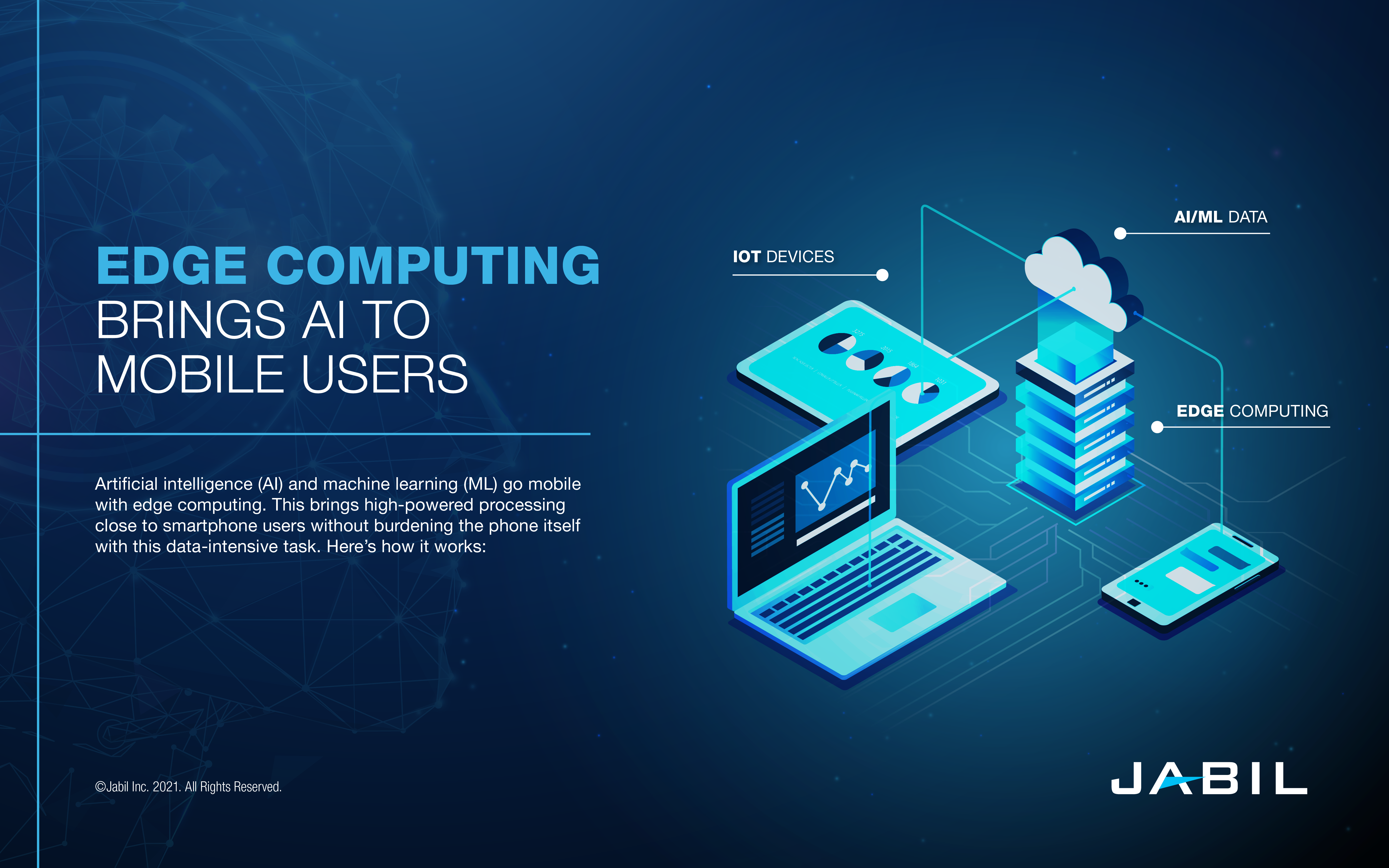
Edge computing brings artificial intelligence to mobile users
It is not a big leap to imagine a disruptive company, perhaps currently germinating in the 5G ecosystem, applying technologies like these to an application that has "killer" potential.
5G Is the Future. The Future Is Probably Coming Soon.
The headwinds facing 5G (specification complexity, spectrum availability, and the absence of a killer app) are not insignificant. At least for now, 5G has not yet led to substantial economic growth the way 4G did in the last decade. It's estimated that between 2011 and 2019, 10% of U.S. GDP growth was due to the wireless industry (powered by 4G). This obviously has yet to happen with 5G.
Despite the complexity of mission, complexity of technology, complexity of economics, and complexity associated with uncertainty, 5G is clearly progressing. This progress is not only in technology and investment, but perhaps more importantly, the ecosystem of players is maturing greatly. The traditional linear business model historically prevalent in wireless is transforming. The 5G world will continue to see an influx of new players, and companies might find themselves customers, suppliers and partners all at the same time.
Given this, the successful players in the 5G space will be exceptional at collaboration and will play active roles in a broader ecosystem. This is a great advantage that 5G has over previous generations, and I believe it will power 5G strongly through the current headwinds. Teamwork, flexibility and a whole lot of creativity will be key to putting together the 5G puzzle.
The future of 5G is bright, and it is probably soon.
Download the 5G Technology Trends Survey Report
Insights from 193 telecommunications decision-makers on 5G adoption, predictions, opportunities and challenges.
